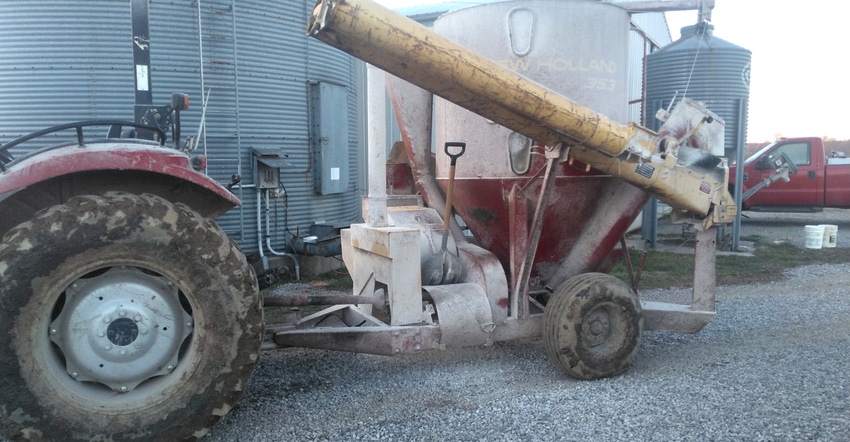November 23, 2022

You could say grinding feed runs in my blood. It was one of the first farm chores I can remember helping my dad with. If you were to ask a farmer what the most vital pieces of equipment are on the farm, you would probable expect to hear answers such as combine, tractor, skid-steer loader, etc.
However, for a farrow-to-finish hog, market steer and feeder lamb operation, could there be a worse situation than the grinder mixer breaking down? For many livestock operations, it would probably be considered one of the most used pieces of equipment on the farm.
It is thought that grinding grain for livestock feed started around 1860, and one of the first feed grinders invented was called the burr mill made by the Letz Manufacturing Co. in Crown Point, Ind.
By 1930, the hammer mill was created, revolutionizing speed and quality of grinding feed. The grinder to this day is still highly used, and the selling point remains the same — to make grain more digestible to livestock.
As farmers, veterinarians and livestock nutritionists learned more about livestock anatomy, improvements and modifications have been made to help improve the operations of the feed grinder and avoid animal health problems that can arise from grinding feed too fine.
Love-hate relationship
For both large and small ruminant producers, there is an ongoing love-hate relationship with feed grinders, and there is a debate whether they are truly needed. Processing or grinding grain has some bright sides such as increasing digestibility of grain.
When large grains such as corn or small grains like wheat and spelts are processed by rolling or grinding, the surface area of the grain is increased in the rumen. As the surface area increases, digesting rumen bacteria will adhere to the grain and break it down more rapidly.
As the surface area of the grain is increased by processing or grinding, these bacteria will produce high amounts of lactic acid, in turn making the rumen pH drop dramatically to levels below 5.5 pH. When this happens, the animal’s blood pH will drop as well, and when the animal’s blood pH levels become too acidic, a chain reaction of reduced esophagus muscle movement will occur — leading to restricted regurgitation or cud chewing all while fermentation continues.
The cud-chewing process is essential for the release of gases from the rumen, and when this process is halted or restricted, bloat will occur. Bloat can be life threatening, causing suffocation.
When the rumen pH drops too low, another condition call acidosis can occur. There are two types of acidosis: chronic and acute.
Chronic acidosis is when cattle will go off feed to compensate for digestive upset. Chronic acidosis can result in cattle eating a lot one day, and then going off feed for a couple of days. Chronic acidosis can quickly lead to acute acidosis, when cattle gorge themselves after getting over their stomachache. Acute acidosis quickly leads to bloat and death when left untreated.
Is the grinder still needed?
Cattle feeders have struggled with bloat and acidosis for a long time, and some question if the feed grinder mixer is still needed on the farm, and should grains even be ground for large and small ruminant livestock? The answer is, it depends. I believe the grinder mixer still has a place on a cattle farm, but it should be used with caution.
Some ways you can still use your feed grinder, sleep soundly at night and keep your local feed grinder salesman in business include the following best practices:
Look at roller mills. If you are looking at buying a new feed mixer, look at roller mill options.
Remove the screen. If you are on a budget and want to still use your hammer mill grinder, remove the screen, which will allow for cracking of the grain rather than pulverizing. Or you could buy large whole 1- to 2-inch screens, which can be used for larger cracking.
Watch your tractor RPM. 540-PTO-driven tractors operating at 1,800 rpms allow for proper processing. Running tractor rpms too fast can lead to over-grinding.
Mix properly. Putting supplements and premixes in before grinding can allow for better feed mixing. Allow feed to mix for 3-5 minutes after grinding.
Don’t blame the grinder on poor bunk management. Take time to watch how much feed is left in bunks after feeding and adjust as needed. Don’t allow automatic feeders to run out, and adjust feeder doors to make cattle work for their feed.
In summary, I won’t be selling my feed grinder mixer anytime soon, but I will be more cognizant on how I use it. Processing grain can help increase digestibility and improve animal performance when done at the right rate and amount.
Building a good relationship with a nutritionist or veterinarian is important for maintaining animal health. Management can cure many health issues; watching your cattle closely at feeding and evaluating feeders, bunks and livestock stools prevents bloat and acidosis. Following all these steps can lead to a better relationship with your feed grinder mixer.
Purdin is the OSU Extension educator for AgNR in Adams County. He is also a member of the OSU Extension Beef Team that publishes the weekly Ohio BEEF Cattle letter, which can be found at beef.osu.edu.
Source: OSU
You May Also Like




